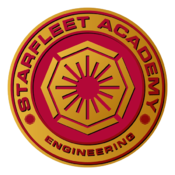Starfleet Engineering School/Components Engineering: Difference between revisions
Jump to navigation
Jump to search
No edit summary |
(Added description of courses) |
||
| (2 intermediate revisions by one other user not shown) | |||
| Line 9: | Line 9: | ||
* '''<span style="color:green">ENG233: Sensors, Communications and Helm Systems</span> | * '''<span style="color:green">ENG233: Sensors, Communications and Helm Systems</span> | ||
** The design and maintenance of transmission and reception systems covering the complete range of available frequencies, from subspace emissions through electromagnetic radiation. Cadets learn communication and sensor protocols, signal traffic management, multiplexing, signal degradation and enhancement, and distribution of sensor time for maximum efficiency. | ** The design and maintenance of transmission and reception systems covering the complete range of available frequencies, from subspace emissions through electromagnetic radiation. Cadets learn communication and sensor protocols, signal traffic management, multiplexing, signal degradation and enhancement, and distribution of sensor time for maximum efficiency. | ||
* '''ENG234: Deflectors, Weapons and Security Systems''' | |||
** Introductory course on tactical and security engineering systems for non-engineering majors. | |||
* '''ENG330: Bio-Neural Components''' | * '''ENG330: Bio-Neural Components''' | ||
** Complete course on the expanding field of Bio-Neural circuitry. | ** Complete course on the expanding field of Bio-Neural circuitry. | ||
| Line 23: | Line 25: | ||
* '''ENG433: Security Systems''' | * '''ENG433: Security Systems''' | ||
** Students study technological systems designed to enhance and provide security, including security force fields, locks and access devices, dampening fields, surveillance equipment, and the maintenance of security devices. Students learn to use security devices in a variety of simulation designed to test their limits. As a final exam, student teams work to design security measures for a situation presented by the instructor, while other students attempt to bypass the security and reach a prearranged goal. | ** Students study technological systems designed to enhance and provide security, including security force fields, locks and access devices, dampening fields, surveillance equipment, and the maintenance of security devices. Students learn to use security devices in a variety of simulation designed to test their limits. As a final exam, student teams work to design security measures for a situation presented by the instructor, while other students attempt to bypass the security and reach a prearranged goal. | ||
* '''ENG530: System Design''' | |||
**A complete discourse on the design behind Starfleet systems, from Weapons systems to Life Support. The engineering and schematic principles behind the systems are explained. Students are ordered to complete a design of a mayor system of their own choosing. | |||
* '''ENG531: Systems Architecture''' | |||
**The full course on designing and implementing systems on Starships. The electronic and mechanical design is explained. EPS schematics and other networks onboard ships are explored. Students are ordered to complete a schematic of an EPS circuitry network on a part of a starship. | |||
* '''ENG532: Systems Dynamics''' | |||
**The principles behind systems dynamics is explained. This includes courses on Thermodynamics, Energy theory, and network electronics. The EPS circuits are explored again, but with an emphasis on energy flow, temperature, and electrical signalling. The Dynamics of all mayor starship systems are included. Student must complete energy schematics for each of a starship's mayor systems. | |||
* '''ENG535: Advanced Replicator Theory and Application''' | |||
**A continuation of ENG232, advanced Replicator theory is explained. This includes courses on Replicator design, engineering principles, reprogramming of Replicators. Advanced applications, including metallurgy, pharmaceutics, and weaponry, are also explained. | |||
* '''ENG536: Advanced Transporter Techniques, Technology and Theory''' | |||
**Another continuation of ENG 232, advanced Transporter theory is explored. High-warp transports and ship-to-ship are explained in full. Experimental techniques are explored as well. Foreign transporter systems, such as those of the Klingons, Cardassians, and Romulan, are studied in full, comparing components and techniques to Federation standards. | |||
{{Academydepts}} | {{Academydepts}} | ||
[[Category:StarFleet Academy Curriculum]] | [[Category:StarFleet Academy Curriculum]] | ||
Latest revision as of 17:49, 20 May 2019
| Academy Library |
|---|
Components EngineeringCourses highlighted in bold green are Academy Core Courses.
|
| Academy Course Catalogue |
|---|

